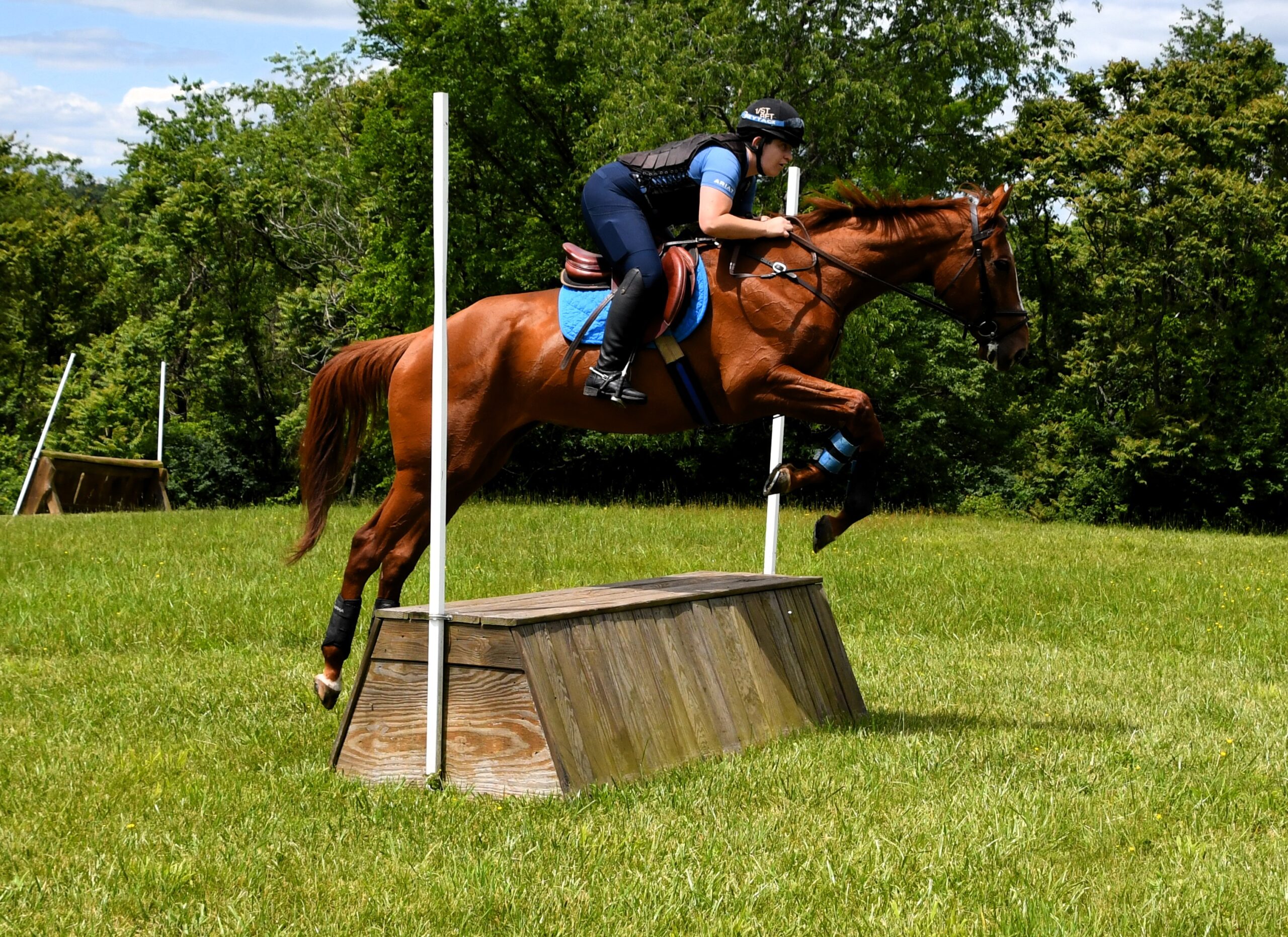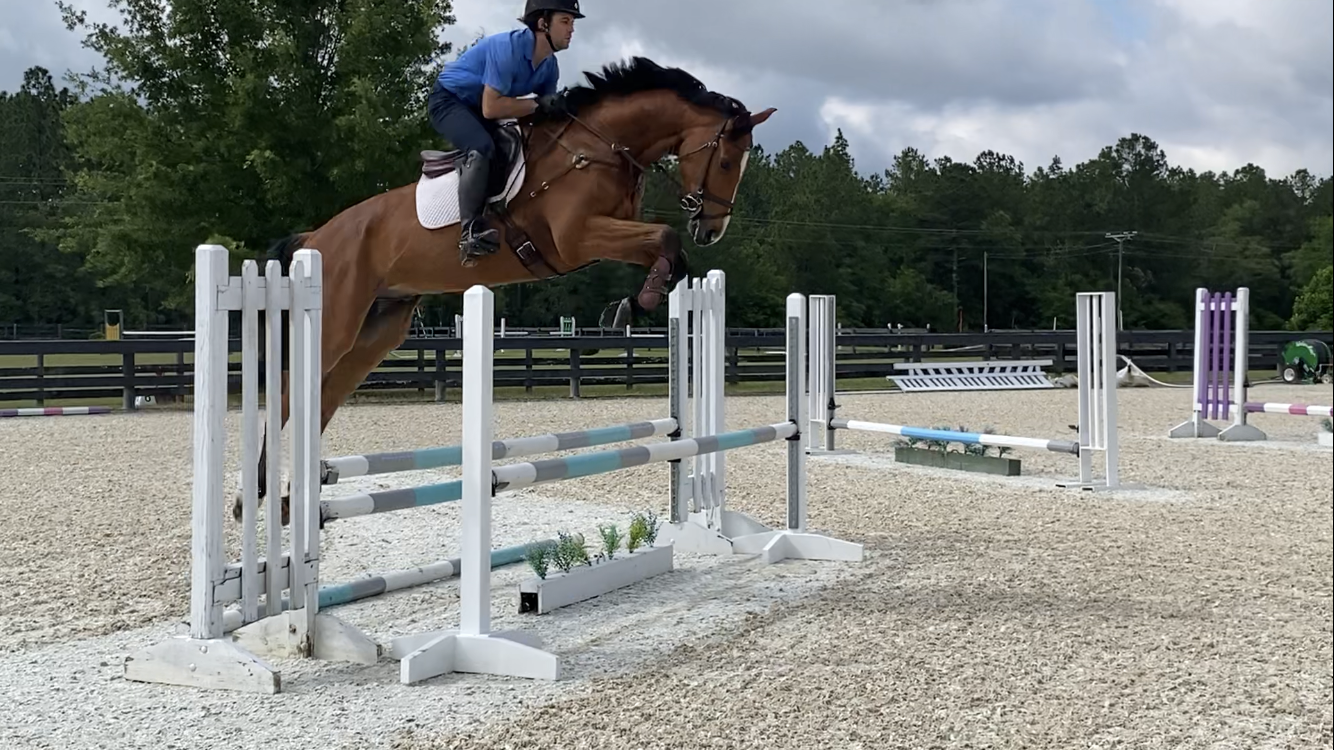
–
Once again Sinead started each session chatting to the group about the general goals of the day, and about how yesterday’s lessons on the flat and in the arena would help them out here in the open. Making good use of the available space, terrain and jumps she managed to test everyone without over-facing anyone. One rider cantered back to the group after jumping, beaming smile, and announced in revelatory tones, “I needed someone to tell me I could touch his face!” Sinead merely laughed, “I’m your woman!” Several times she told riders to have the conversation with their horse earlier so they were doing less right in front of the fence, to do your home work, the moving away from the leg and then coming back in canter as a test, as they’d done in the warm up yesterday, far away from the fence and then make any necessary adjustments sooner. Once again I was impressed by how articulate she was, and want to share her words with you.

” Talking about cross country, it’s certainly something that keeps evolving and it’s very important that whoever you ride with, or the events you go to, you start to notice the trend of what’s happening, and I actually think that on the whole we’re getting back to a really good place with our cross country riding and our building. It’s funny because you talk to a lot of people about the ‘good old days’ and for some reason in my head I thought that back then it was just fields full of massive galloping fences and you just galloped them fast, and that was that! But I was on the phone with Lucinda Green about a month ago and I was asking her about it, and what the courses were like, and she told me that the jumps were actually so significant, and the questions that they were asking were so blatant, nothing hidden, but there were serious terrain changes and serious questions that you HAD to make adjustments- you HAD to make adjustments or else you’d get in a lot of trouble, and I think out of the six times she won Badminton she won once with ten time penalties and I think she won another time with seventeen time penalties. You just couldn’t jump the jumps without making a serious change, and of course the horses had to be bold and brave and all of that stuff. Our sport keeps changing and asking us to be better riders, better on the flat, better in the show-jumping, better on cross-country, asking us for that adjustability, and to be able to go and jump a galloping fence and then make a significant change to jump an exercise. I think we’ve shifted around with types of horses that do the job and that sort of thing, trying to get big-moving dressage horses and show-jumping horses and teach them the cross country and then that didn’t quite work because they still had to have the heart and bravery and the adjustability, so it comes back to that management but not over micro-management.
If you watch the riders that are really winning now, and the riders that were really winning then, they made very significant changes in their gallops and what they were doing, the horses always had a lot of heart and were very brave, but position-wise there were a few things that were really fundamental that we don’t teach enough now, I think, and that is really making an adjustment and then putting the responsibility back on the horses. If you think about a horse running cross country, number one, if they can see a fence and if their eyes are on it, even if they get to it wrong, rarely are they going to have a fall. If you go back and watch a fall or something that went wrong most of the time it’s because a horse wasn’t accepting something that the rider was saying; so that leads you to three things – either the rider’s not saying it right, the rider’s saying it too loudly, or the rider has said it too late. When you’re making an adjustment on course, and it’s something to really teach these young horses is that your homework starts well away from the fence, because at the point when you get within four of five strides of that fence you need to have everything done because at that point you really want to make sure that the horse’s ears are looking at what they’re doing, that they’re focused on what they’re doing. At that point I pass the responsibility back, I’ve done my homework early enough, I’ve picked my speed, I’ve picked my rhythm, I’ve picked my line, I’m hoping that at that point I can let the horse pay attention to their job.
Position wise – the classic slipping rein. It’s a really important place to go. If you watch the really top riders from now, and from before it’s an instinctual thing when a horse starts to spook or when something’s a little wrong to go to the back of the rein. We’ve become so into management that we’ll tend to always ride on a shorter, tighter rein and when a horse starts to balk, or get nervous, or if something goes a little wrong the horse feels restricted and he can’t use his neck or his shoulder, and that’s the balance he needs to jump on terrain, to cope with things that are a little off or a little wrong. They need their neck and that balance and that confidence that you’re not getting in their way. That slipping rein when things are going a little wrong is incredibly important, you come back to the back of the saddle, you ride the engine and the compromise is that you want to keep that engine going but you give the horse his neck and his shoulder, so then he can jump, and you’re in a place that is quite safe. Phillip Dutton for example, is probably one of the most unusual styles you’ll watch cross country, and yet he’s one of the best technicians and the best cross country riders in the world; it’s because he rides in quite an upright place with quite a long rein and those horses are MOVING behind.
There’s that balance in the cross country and in everything that we do, that we have to train our horses, we have to be aware of what a good canter is, what the appropriate gallop is for the appropriate fence, and then we have to put it back on them, so with our younger horses and with our younger riders we do train the cross country to a point, we train the rideability, we train ourselves to recognize what that good canter is and then we give it back to them, and that’s the end of that sentence. That the whole point of the training is then to put it back on the horse, and give them a chance to develop the confidence to feel like Superman out there, and it’s amazing how it all comes back to you when you’re tripping going downhill to an upright vertical and you slip that rein and the horse is looking where he’s going – what you’re saying at that moment is very important that the horses do learn to look for a jump starting at a young age. I trot a lot of skinnies and a lot of narrows, because a lot of the questions on our courses now are instinct, footwork and honesty – skinny triple brushes at the bottom of banks that you just can’t hold them to, you have to stay in the middle and say there it is and the horses have to learn to go and jump it. There comes a point at the levels where they just have to know what’s in front of them and go and jump that, so that starts in training your young horse to go and trot down to a skinny and be honest about it, and not have to force it. I really like where our cross country is getting back to because it’s requiring all these things, and I think we’re getting a little bit better about the types of horses we’re taking out, we are getting back to some blood and the thoroughbreds are out there doing it, and the bravery and that heart, and they just have to be genuine. If you get to that point where you get really good at just slipping back with that longer rein, and your horse is looking for a way out, that might be a horse you might want to sell, to be honest, I don’t want to ride that! At the preliminary level and above they’ve got to want to play the game, and I think we need that horse in the sport.”
Sinead has just moved to a new barn in New Jersey with what she described as a palatial indoor as well as superb facilities, and told me she feels incredibly lucky. Partly because of this, and partly because she was away from home for six months this year, she intends to stay at home until February this winter when she’ll re-locate to Ocala to base herself out of Clayton Fredericks’ farm. Tate (Manoir De Carneville) is still out “in a giant field, fat and furry with no shoes on” with two Clydesdale yearlings for company; he’ll come back into work on 9th December.
*******************************************************
Everyone that I spoke to who rode with Sinead in the clinic was thrilled with the results and eager to sign up for the next one, surely a ringing endorsement! Keep an eye out for the next installment of the Training Diaries with Allie Slusher which will feature her two horses Komik and Roxy in the clinic, and a huge thank you again to Allie for hosting, to Sinead, and to you for reading. Go Eventing!






















